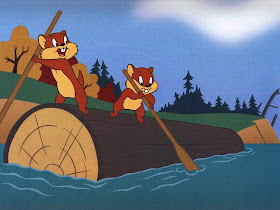The 1955 Warner Bros.’ cartoon, Goofy Gophers in Lumber Jerks, ends with a line from one of the gophers that illustrates the 1950s lifestyle: “Isn’t our house much better than it was before?” he asks his partner as he looks up at a “tree” built of furniture sawed from what had once been their tree home. A television set tops off this house of furniture that stands alone among the stumps—what is left of a forest clear-cut for its lumber. The gophers seem happy with their new home—merely commenting “it will be better when we have electricity.” But after seeing the consequences of “progress” as depicted in the cartoon, devastation of our forests, are we meant to answer “yes” to the gopher’s question? Does the cartoon argue that “our house [is] much better than it was before?”
With this parting question, Goofy Gophers and the Lumber Jerks becomes a model enviro-toon. As Jaime Weinman explains, it “never preaches . . . . And instead of showing that only evil people harm the environment, it shows that trees are being chopped down in order to make the things we use every day—in other words, we are the ones harming the environment.” Lumber Jerks seems to emanate from an attitude in 1950s America that Klein calls “Consumer Cubism” (210), “an obsession with the efficient, angular plan.” The faster a consumer could gain access to goods, the better. Klein claims “individualism and democracy were being redefined in terms of consumer desire. The homogeneous surface, open and ‘free,’ came to stand in for America’s imperium” (210). These attitudes were reflected in both narrative and aesthetics of cartoons after 1954.
Lumber Jerks moves viewers gradually to this environmentalist, anti-consumerism message. It first focuses on saving one tree in a forest—but the conclusion differs dramatically. Two cheerful gophers scurry toward their home tree, but when they go up into the hollow of the tree, they find it has been cut down and carried away. The two gophers take steps to retrieve their tree—what they call their property—tracking it to a river and then picking it out of the hundreds of logs floating on the water. They climb on their tree and row away but cannot fight the current and nearly go over a waterfall. Once they escape, one gopher exclaims, “I’m bushed,” and the two fall asleep, waking up only after entering a lumber mill, surviving a saw blade cutting their tree trunk in two.
After seeing the devastation around them, the gophers state the obvious about the repercussions of consumerism. One of the gophers explains, “It looks like they are bent on the destruction of our forests,” and the scene shifts to the mill’s workings. One “shot” shows trees ground into sawdust being made into artificial fireplace logs. Another shows an entire tree being “sharpened” to produce one toothpick. Then the gophers discover what had happened to their own tree: “They’re going to make furniture out of our tree,” states one. But the idea of ownership of consumer goods extends to the gophers and their tree home. They wish to reclaim their property, their own possession, so the other gopher exclaims, “That is definitely our property. We must think of a way to repossess it.” The gophers siphon the gas out of the furniture truck and, when it breaks down, “steal” their tree’s furniture from the truck. They build a tree house with the furniture, adding branches for good measure and topping the tree off with a television set.
The cartoon ends with one of the gophers telling the other, “Isn’t our home much better than it was before ….[we have] Television… and just think how much better it will be with electricity!” Because the gophers view their tree home as a possession not unlike the furniture produced from its wood, they seem pleased with their “repossession.” But the enviro-toon leaves viewers feeling ambivalent about the price of progress.
Lumber Jerks combines a critique of consumerism with a statement about its source—natural wilderness—but seems to also endorse interdependence between humans and the natural world (and between progress and conservation), at least to the extent that furniture built from a tree trunk can return to the forest as the Goofy Gophers’ home. With its overt focus on consumerism, however, the ‘toon goes further than the other shorts we examined here. It leaves viewers questioning the Goofy Gopher’s conclusion stated in the opening: “Isn’t our house much better than it was before?”






No comments:
Post a Comment